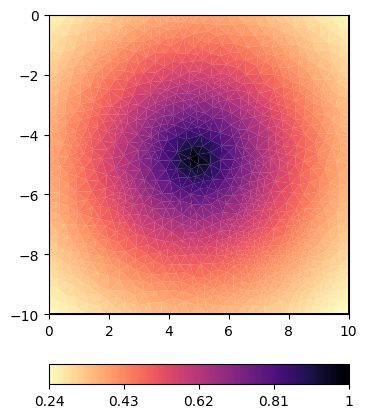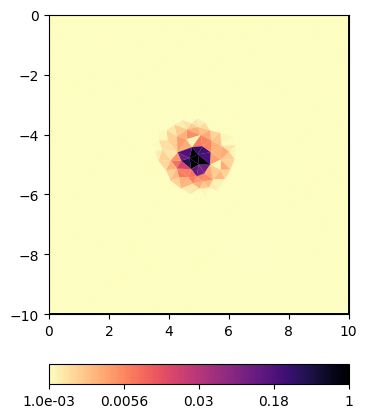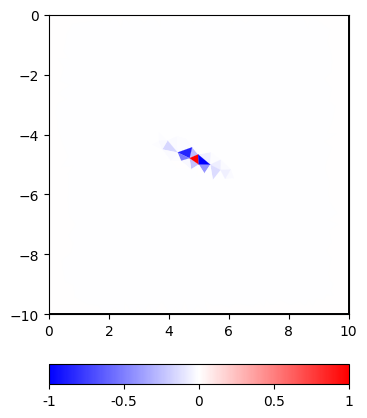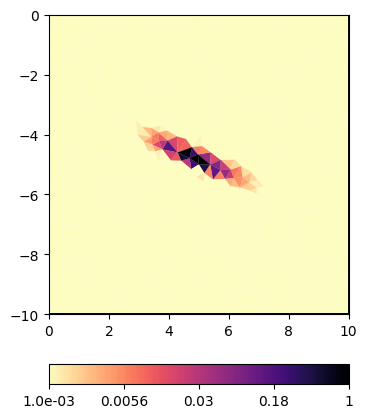Note
Go to the end to download the full example code
Geostatistical regularization#
In this example we illustrate the use of geostatistical constraints on irregular meshes as presented by [Jordi et al., 2018], compared to classical smoothness operators of first or second kind.
The elements of the covariance matrix \(\textbf{C}_{\text{M}}\) are defined by the distances H between the model cells i and j into the three directions
It defines the correlation between model cells as a function of correlation lenghts (ranges) \(I_x\), \(I_y\), and \(I_z\). Of course, the orientation of the coordinate axes is arbitrary and can be chosen by rotation. Let us illustrate this by a simple mesh:
Computing covariance and constraint matrices#
We create a simple mesh using a box geometry
import matplotlib.pyplot as plt
from matplotlib.patches import CirclePolygon
from matplotlib.collections import PatchCollection
from matplotlib.colors import LogNorm
import numpy as np
import pygimli as pg
import pygimli.meshtools as mt
from pygimli.frameworks import PriorModelling
# We create a rectangular domain and mesh it with small triangles
rect = mt.createRectangle(start=[0, -10], end=[10, 0])
mesh = mt.createMesh(rect, quality=34.5, area=0.1)
# We compute such a covariance matrix by calling
CM = pg.utils.covarianceMatrix(mesh, I=5) # I taken for both x and y
# We search for the cell where the midpoint (5, -5) is located in
ind = mesh.findCell([5, -5]).id()
# and plot the according column using index access (numpy)
ax, cb = pg.show(mesh, CM[:, ind], cMap="magma_r")

According to inverse theory, we use the square root of the covariance matrix as single-side regularization matrix C. It is computed by using an eigenvalue decomposition
based on LAPACK (numpy.linalg). The inverse square root is defined by
In order to avoid a matrix inverse (square root), a special matrix is derived
doing the decomposition and storing the eigenvectors and eigenvalues values.
A multiplication is done by multiplying with Q and scaling with the diagonal.
This matrix is implemented in the matrix module
by the class pg.matrix.Cm05Matrix
Cm05 = pg.matrix.Cm05Matrix(CM)
However, this matrix does not return a zero vector for a constant vector
out = Cm05 * pg.Vector(mesh.cellCount(), 1.0)
print("min/max value ", min(out), max(out))
min/max value 0.02159243432153619 0.20503355104237836
as desired for a roughness operator. Therefore, an additional matrix called
pg.matrix.GeostatisticalConstraintsMatrix
was implemented where this spur is corrected for.
It is, like the correlation matrix, created by a mesh, a list of correlation
lengths I, a dip angle that distorts the x/y plane and a strike angle
towards the third direction.
C = pg.matrix.GeostatisticConstraintsMatrix(mesh=mesh, I=5)
In order to extract a column, we generate a vector with a single 1, multiply
vec = pg.Vector(mesh.cellCount())
vec[ind] = 1.0
cor = C * vec
and plot it using a linear or logarithmic scale
The constraints have a rather small footprint compared to the correlation if one considers values below a certain threshold as insignificant.
Such a matrix can also be defined for different ranges and dip angles, e.g.
Even in the linear scale, but more in the log scale one can see the regularization footprint in the shape of an ellipsis.
In order to illustrate the role of the constraints, we use a very simple mapping forward operator that retrieves the values in the mesh at some given positions. The constraints are therefore used as interpolation operators. Note that the mapping forward operator can also be used for defining prior knowledge if combined with another forward operator in a classical joint inversion framework. In the initialization, the indices are stored and a mapping matrix is created that projects the model vector to the forward response. This matrix is also the Jacobian matrix for the inversion.
Inversion with geostatistical constraints#
We choose some positions and initialize the forward operator
pos = [[2, -2], [8, -2], [5, -5], [2, -8], [8, -8]]
fop = PriorModelling(mesh, pos)
# For plotting the results, we create a figure and define some plotting options
fig, ax = plt.subplots(nrows=2, ncols=2, sharex=True, sharey=True)
kw = dict(
colorBar=True,
cMin=30,
cMax=300,
orientation='vertical',
cMap='Spectral_r',
logScale=True)
# We want to use a homogenenous starting model
vals = np.array([30, 50, 300, 100, 200])
# We assume a 5% relative accuracy of the values
relError = 0.05
# set up data and model transformation log-scaled
tLog = pg.trans.TransLog()
inv = pg.Inversion(fop=fop)
inv.transData = tLog
inv.transModel = tLog
inv.startModel = 30 # for all
# Initially, we use the first-order constraints (default)
# inv.setRegularization(cType=2)
res = inv.run(vals, relativeError=relError, cType=1, lam=30)
print(('Ctype=1: ' + '{:.1f} ' * 6).format(*fop(res), inv.chi2()))
pg.show(mesh, res, ax=ax[0, 0], **kw)
ax[0, 0].set_title("1st order")
np.testing.assert_array_less(inv.chi2(), 1.2)
# Next, we use the second order (curvature) constraint type
res = inv.run(vals, relativeError=relError, cType=2, lam=25)
print(('Ctype=2: ' + '{:.1f} ' * 6).format(*fop(res), inv.chi2()))
pg.show(mesh, res, ax=ax[0, 1], **kw)
ax[0, 1].set_title("2nd order")
np.testing.assert_array_less(inv.chi2(), 1.2)
# Now we set the geostatistic isotropic operator with 5m correlation length
res = inv.run(vals, relativeError=relError, lam=15, C=C)
print(('Cg-5/5m: ' + '{:.1f} ' * 6).format(*fop(res), inv.chi2()))
pg.show(mesh, res, ax=ax[1, 0], **kw)
ax[1, 0].set_title("I=5")
np.testing.assert_array_less(inv.chi2(), 1.2)
# and finally we use the dipping constraint matrix
res = inv.run(vals, relativeError=relError, lam=15, C=Cdip)
print(('Cg-9/2m: ' + '{:.1f} ' * 6).format(*fop(res), inv.chi2()))
pg.show(mesh, res, ax=ax[1, 1], **kw)
ax[1, 1].set_title("I=[9/2], dip=25")
np.testing.assert_array_less(inv.chi2(), 1.2)
# plot the position of the priors
patches = [CirclePolygon(po, 0.2) for po in pos]
for ai in ax.flat:
p = PatchCollection(patches, cmap=kw['cMap'])
p.set_facecolor(None)
p.set_array(np.array(vals))
p.set_norm(LogNorm(kw['cMin'], kw['cMax']))
ai.add_collection(p)
![1st order, 2nd order, I=5, I=[9/2], dip=25](../../_images/sphx_glr_plot_6-geostatConstraints_006.png)
Ctype=1: 31.5 51.2 272.8 99.7 193.4 1.0
Ctype=2: 30.0 49.7 298.4 100.5 198.7 0.0
Cg-5/5m: 30.0 47.7 290.4 96.2 193.2 0.5
Cg-9/2m: 30.0 47.7 290.4 96.2 193.2 0.5
Note that all four regularization operators fit the data equivalently but the images (i.e. how the gaps between the data points are filled) are quite different. This is something we should have in mind using regularization.
Generating geostatistical media#
For generating geostatistical media, one can use the function generateGeostatisticalModel. It computes a correlation matrix and multiplies it with a pseudo-random (randn) series. The arguments are the same as for the correlation or constraint matrices.

Total running time of the script: (1 minutes 12.732 seconds)



